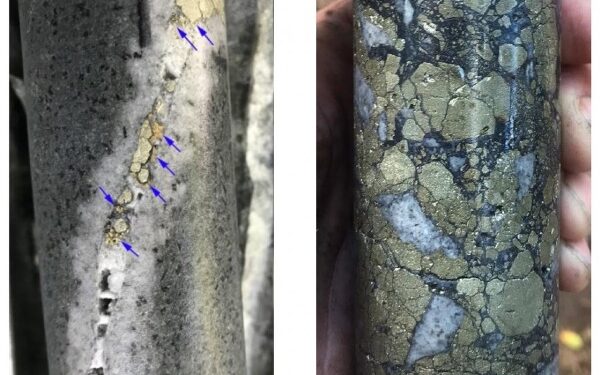Targeting Deep High-Grade Feeder at Tuvatu
Lion One Metals Limited (TSXV: LIO) (OTCQX: LOMLF) (ASX: LLO) has received promising assay results from ongoing deep step-out drilling at the company’s 100% owned Tuvatu gold project in Fiji.
Multiple high-grade gold intercepts have been encountered in TUDDH533. The deepest intercept of 55.44 g/t Au over 2.30m (including 221.60 g/t over 0.40m) from a downhole depth of 575.70m, is believed to be a continuation of the same structure that encountered 55.44 g/t over 12.70m in TUDDH500, 40m to the SW, in July 2020.
Evidence is growing that this deep NE-oriented structure is nearly vertical, with a strike length of at least 360m, and vertical extent of at least 720m from surface. It is believed to be an extension of the high grade UR4 lode, open both at depth and along strike where it projects from the Tuvatu resource area to the Banana Creek target 3.5km to the NE.
Highlights include:
- 18.96 g/t Au over 0.65m beginning at a down hole depth of 13.00m
- 437.13 g/t Au over 0.60m beginning at a down hole depth of 266.80m
- 16.14 g/t Au over 1.45m beginning at a down hole depth of 309.35m
- 55.44 g/t Au over 2.30m including 221.60 g/t Au over 0.40m from 575.70m
Dr Quinton Hennigh, technical advisor to Lion One, said the company this deep intercept from TUDDH533 to be part of the same important structure as TUDDH500 with both intercepts displaying strong visual similarities including coarse pyrite and visible gold in gray silica within centimetric-scale veins with distinct light gray potassium feldspar alteration halos around the veins.
Several shallower high-grade intercepts in hole TUDDH533 are also very important, especially 473.13 g/t Au over 0.60m occurring at 266.80m down hole depth. Veining in this area appears almost perpendicular to core suggesting this high-grade intercept possibly represents a flat lode.
Such flat lodes, known as the SKL group, are common higher up at Tuvatu. If this intercept is indeed from a flat lode, it would be the deepest known flat lode at Tuvatu. Lion One believes that the ore-forming fluids that generated the high-grade feeder discussed above may have found their way into nearby fractures thus forming lodes similar to those seen in the SKL group.
“The deep high-grade intercept encountered in hole TUDDH533 is almost certainly from the same high-grade structure encountered in hole TUDDH500 late last July,” commented Dr. “Visual appearances of these two intercepts are strikingly similar. We are now growing comfortable with the idea that this is a northeast-trending, near vertical lode, likely the down-dip and strike continuation of the UR4 lode,” Dr Hennigh said.
“This is very exciting, because this lode remains open to the northeast and at depth. In fact, this lode projects toward the Banana Creek target approximately 3.5km to the northeast from Tuvatu. It is intriguing to think that the UR4 structure might be a main mineralising conduit that could tie together the bigger gold system within the Navilawa caldera. Lion One has several deep drill holes planned at Banana Creek this drill season.”
The xompany is currently undertaking three tiers of drilling: 1) shallow resource infill drilling from surface, 2) resource infill drilling from underground and 3) deep exploration drilling looking for lode extensions under the Tuvatu resource and soon, other target areas within the Navilawa caldera such as Banana Creek, 3.5 km NE of Tuvatu.
For further information please visit: https://liononemetals.com/












